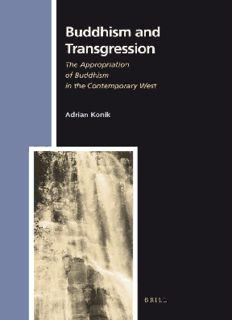
Buddhism and Transgression: The Appropriation of Buddhism in the Contemporary West PDF
Preview Buddhism and Transgression: The Appropriation of Buddhism in the Contemporary West
Buddhism and Transgression Numen Book Series Studies in the History of Religions Series Editors Steven Engler (Mount Royal College, Calgary, Canada) Richard King (Vanderbilt University, Nashville, U.S.A.) Kocku von Stuckrad (University of Amsterdam, The Netherlands) Gerard Wiegers (Radboud University Nijmegen, The Netherlands) Advisory Board b. bocking (london, uk); f. diez de velasco (tenerife, spain); i. s. gilhus (bergen, norway); g. ter haar (the hague, the netherlands); r. i. j. hackett (knoxville, tn, usa); t. jensen (odense, denmark); m. joy (calgary, canada); a. h. khan (toronto, canada); p. p. kumar (durban, south africa); g. l. lease (santa cruz, ca, usa); a. tsukimoto (tokyo, japan); a. t. wasim (yogyakarta, indonesia) VOLUME 125 Buddhism and Transgression The Appropriation of Buddhism in the Contemporary West By Adrian Konik LEIDEN • BOSTON 2009 Cover illustration: Pointing out possibilities in the flow (by Inge Konik, 2007). This book is printed on acid-free paper. Library of Congress Cataloging-in-Publication-Data Konik, Adrian. Buddhism and transgression : the appropriation of Buddhism in the contemporary West / by Adrian Konik. p. cm. — (Numen book series. Studies in the history of religions ; v. 125) Includes bibliographical references and index. ISBN 978-90-04-17875-5 (hardback : alk. paper) 1. Buddhism—Western countries. 2. Buddhist philosophy. I. Title. II. Series. BQ704.K66 2009 294.309182’1—dc22 2009026762 ISSN 0169-8834 ISBN 978 90 04 17875 5 Copyright 2009 by Koninklijke Brill NV, Leiden, The Netherlands. Koninklijke Brill NV incorporates the imprints Brill, Hotei Publishing, IDC Publishers, Martinus Nijhoff Publishers and VSP. All rights reserved. No part of this publication may be reproduced, translated, stored in a retrieval system, or transmitted in any form or by any means, electronic, mechanical, photocopying, recording or otherwise, without prior written permission from the publisher. Authorization to photocopy items for internal or personal use is granted by Koninklijke Brill NV provided that the appropriate fees are paid directly to The Copyright Clearance Center, 222 Rosewood Drive, Suite 910, Danvers, MA 01923, USA. Fees are subject to change. printed in the netherlands To Inge, for everything CONTENTS Foreword ............................................................................................. ix Preface .................................................................................................. xiii Acknowledgments .............................................................................. xv List of illustrations ............................................................................. xxiii List of abbreviations .......................................................................... xxv Introduction ........................................................................................ 1 PART I THE EMERGENCE OF DISCIPLINARY/BIO-POWER AND THE ARISING OF DISCURSIVE TENSION IN WESTERN SOCIETY Chapter One The problem of effective critique ......................... 19 Chapter Two Disciplinary/bio-power and rational autonomy ........................................................................................ 29 Chapter Three Secularized/medicalized confession and the problematization of rational autonomy ..................................... 41 PART II A REAPPRAISAL OF WESTERN INTEREST IN TIBET AND VAJRAYĀNA BUDDHISM Chapter Four The blank canvas of Tibet .................................... 65 Chapter Five Lobsang Rampa’s The Third Eye: The Autobiography of a Tibetan Lama ....................................... 79 Chapter Six John Blofeld’s The Wheel of Life: The Autobiography of a Western Buddhist ................................. 95 Chapter Seven Anagarika Govinda’s autobiographical The Way of the White Clouds ....................................................... 107 viii contents PART III ENGAGING WITH THE DISCURSIVE LIMITS OF TRANSGRESSION Chapter Eight The ‘technological mind,’ discourse analysis, and the emergence of a new type of socially engaged contemporary Western Buddhism .............................................. 123 Conclusion .......................................................................................... 167 Afterword ............................................................................................ 177 Bibliography ........................................................................................ 179 Index .................................................................................................... 185 FOREWORD This rich, challenging book by Adrian Konik invites the reader to enter reflectively into the process of the negotiation of religious meaning across often vast geographical, historical, socio-political and cultural divides. The point of entry of this book is an understanding of the dis- crepancy between the primary locus of discontent addressed by early Indian Buddhism, and the one addressed by contemporary Western Buddhism: the former suffered from the anxiety of an interminable series of rebirths; the latter, from the experience of being pressed into and shaped by the mold of power relations and thought patterns domi- nant in the West since the eighteenth century—as analyzed by Michel Foucault. Since the fundamental problems underlying early Indian Buddhism and contemporary Western Buddhism are not the same, the validity of applying the set of solutions developed by the first to the situation of the second becomes a question of great importance. Simply putting an end to rebirth would not necessarily strike the con- temporary Westerner as the ultimate answer, as it certainly was for early Indian Buddhists. So, simplistic repetition, on the part of contemporary Western Buddhists, of any of the forms of historical Eastern Buddhism, or Hīnayāna (Theravāda) and Mahāyāna Buddhism, would amount to ahistoric Buddhist fundamentalism—in the terminology of the author, to mere nostalgia, Orientalism, and ornamentalism. The alternative would be to engage in the difficult process of conscious, reflective mediation and articulation. What would constitute the difference between a facile, superficial and ineffectual mediation of meaning, on the one hand, and a responsible, effectual one that is part of a larger intercultural dialogue, on the other hand? Adrian Konik makes a marked contribution to this field. It is a delicate field of interlocking relationships which cannot be easily disentangled. No doubt, according to the early Indian Buddhist tradition, the Buddha’s great discovery, as condensed in his experience of nirvana, involved his remembrance of his many former existences, presupposing as fact the reality of a never-ending process of rebirth as a source of deep anxiety, and an acceptance of the Buddha’s overcoming of that fate as ultimate liberation. This was not an isolated item, but embedded in a nexus of great complexity and reciprocally implied in
